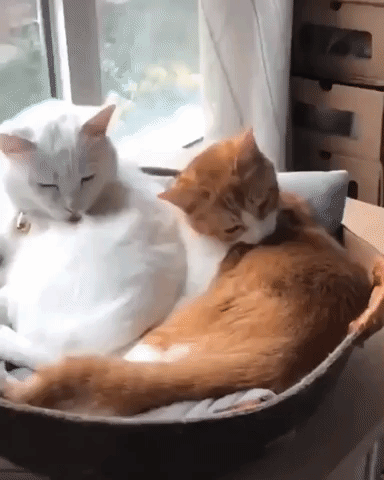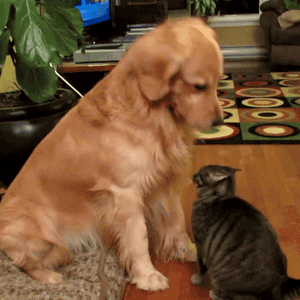Pet-friendly Short-term Rentals: Should You Allow Pets?

Pet-friendly short-term rentals are extremely popular due to an increase in long-term stays and staycations. When you combine that with the fact that around 67% of US households own a pet, you see why allowing them in your vacation home might be a good idea.
Considering how many people own pets, transforming your property into a pet-friendly rental can be a great strategy to increase your hosting income. While it may seem risky to allow pets on your property, there are certain things you can do to protect your accommodation.
Read on to find out about the pros and cons of welcoming furry friends and what you should do to make your vacation rental pet-friendly.

Should You Allow Pets in Your Vacation Rental?
Before making any decisions, it’s always good to do some research and see whether that particular move offers more benefits or downsides. The first and the most obvious thing to consider is allergies.
If you have allergies, then cleaning the place post-stay would be unbearable. If that’s the case, you can only allow hypoallergenic dogs. Alternatively, you can employ a third-party cleaning company to do the cleaning for you. In any case, before you open up your vacation rental property to people traveling with pets, it’s important to weigh up all the pros and cons:
Pros
- You will be able to generate more bookings by marketing your property to a wider audience.
- You can increase your nightly rate as pet owners are willing to pay a bit extra for the opportunity to stay with their pets.
- You can expect a better return on investment with more bookings and an increased nightly rate.
- You will have a unique competitive advantage over other properties in the market that don’t allow pets.
Cons
- Your short-term rental will be more prone to damage and premature wear and tear.
- If animals are making a ruckus, barking, or urinating outside allowed areas, your neighbors might not be happy.
- Since most animals are furry and messy in general, your cleaning costs are likely to go up.
- Tick/flea infestations are always a risk with animals. They’re difficult to spot and are hard to get rid of. This can be dangerous if you have your own pets.
How Much Do Pet-friendly Rentals Make?
While there isn’t an exact amount that can tell you how much pet-friendly vacation rentals make, we have researched some statistical data to get a better understanding of how allowing pets can impact your ROI. So far, owners have reported thousands of dollars of additional revenue on their pet-friendly rentals.
Pet-friendly vacation rental apartments boast a significantly lower vacancy rate, and they’re 16% more expensive compared to non-pet-friendly rentals. Here are some other numbers that will convince you to welcome furry friends in your short-term rental:
- The average pet fee is $50.
- The average pet cleaning fee is $120.
- The average refundable deposit is $200.
- Pet-friendly short-term rentals are 4% more likely to get booked compared to non-pet-friendly properties.
- On average, animal owners pay around $23 extra per night for pet-friendly accommodation.
How Much Should You Charge For Your Pet Fee?
A great thing about owning a pet-friendly short-term rental is the fact that pet owners already expect to see a higher price at the checkout. If talking about traditional rentals, in larger cities, most apartment buildings even charge a monthly pet fee.
As there’s so much cleanup involved, why shouldn’t you also introduce a pet fee? However, keep in mind that charging a flat fee for all guests with pets is not the best move because not all dog breeds require the same level of property upkeep.
For example, larger dogs with long hair are more prone to shedding. On the other hand, you have larger breeds that don’t shed at all — poodles, Portuguese water dogs, Wheaten Terriers, etc. Then, there are other types of pets to consider, such as cats, that usually don’t leave a lot of mess behind.
Most animal-friendly short-term rentals cap their pet fees at $10 to $50 per night, depending on the animal and breed type. You can also include a pet cleaning fee which averages at $120. Some other factors to consider include:
- Size — specify the size of the pet that you can accommodate and take this parameter into account when coming up with a pet fee amount for a specific guest.
- Age — take the age of the pet into consideration since younger dogs tend to misbehave more and younger cats tend to be more playful which may result in more accidents and damage.
- Breed — a hypoallergenic breed would be a plus.
- Potential damage — consider the potential damage that can be caused by different pets and clearly specify which types of pets and breeds you allow at your rental.
How to Create a Pet-friendly Short-term Rental Property?
If you’ve decided that this investment is worth your while, the next step would be to refurbish your place and make it pet-friendly.
Not only will these hints help accommodate your new animal-loving guests, but they will also pet-proof your rental and save your relationship with neighbors.

1. Get your paperwork in order
Give a quick call to your home insurance company to check whether making your property pet-friendly can affect your insurance premium. While most insurance companies allow nearly all dog breeds, cats, as well as fish for little to no charge, it’s still wise to cover all your bases.
Check local policies on vaccinations and licenses beforehand. Create a pet-friendly policy that is clear and comprehensive to avoid any miscommunication with your future guests.
Lastly, make it a requirement that all pets must be vaccinated, tick and flea-free, have a tag, ownership confirmation, and other necessary documentation.
2. Buy pet-friendly fabrics
Use materials that are easy to clean but difficult to destroy. Even though you explicitly ask your customers to keep pets off the couch and bed, more often than not, they’ll just not listen. So, to protect your furniture, use pet-friendly materials. Choose a fabric that is moisture and stain-resistant.
3. Install barriers and pet-proof your rooms
Install dog fences and use mattress covers to protect surfaces and prevent pets from roaming around forbidden areas. Here are some additional tips on how to pet-proof your rooms:
- Use childproof latches to prevent pets from opening cabinets.
- Place toxic and dangerous materials in locked areas or on top shelves.
- Keep trash cans inside cabinets.
- If you have house plants, check whether they are toxic to certain types of animals.
- Install covers on all heating vents.
4. Fit easy-to-clean surfaces
Avoid carpets and textiles that easily absorb liquids or that are prone to stains and damages. Hard-floor surfaces are the easiest to clean, which is why we recommend using materials such as laminate, tiles, or vinyl.
5. Provide water bowls, toys, and other pet supplies
Supply your guests with pet necessities. This move will bring better reviews, more bookings, and less mess. Here are some pet-friendly amenities we recommend to include:
- Dog beds/cat beds
- Extra leashes
- Extra collars
- Chew toys
- Cat scratchers
- Brushes
- Treats
- Water bowls
- Dog gates
- Crates
- Waste bags.
6. Charge a security deposit to protect your property against potential damages
Always request a deposit in case any damages occur during the guests’ stay. We suggest asking for a $150-200 refundable deposit, but you can tweak that price to your liking. Lastly, check local rules and regulations to see whether your state has any particular requirements.
How to Attract Guests to Your Pet-friendly Rentals?

Setting up your rental for pets is one thing, but attracting decent guests is a whole other ordeal. You have to make it obvious and apparent that you accept pets; otherwise, you’ll be investing your time and money in listing optimization without seeing the anticipated ROI. Here’s what you should do to market your property and attract people that hit the road with pets:
-
Update your rental listing
Update your listing on all booking platforms and highlight that it’s pet-friendly. As not so many Airbnbs allow animals, your listing will be more popular. Make sure to add photos and list all pet-friendly amenities. You can also market your listings in pet-owner groups and forums.
-
Mention you are pet-friendly in your rental description
Make sure to utilize SEO principles to increase the visibility of your pet-friendly rentals. Mention that you’re pet-friendly in the title, in the description, and enable specific options which can be found on booking websites. So, when a customer types in ‘’pet-friendly,’’ your listing will be among the top search results.
-
Add your rules relating to pets to your house rules
Create specific rules to avoid any miscommunication between you and your guests. Explore suggestions and tips on the house rules in the section below.
Hints for Pet-friendly Short-Term Rental House Rules
You should create a list of rules for all guests to follow to ensure maximum satisfaction for both parties involved. Here are our top recommendations:
-
The number of animals
Decide what’s the maximum number of animals you would allow inside your rental.
-
Animal types
Decide whether you will allow only dogs and cats or other types of animals like rabbits, fish, snakes, gerbils, etc.
-
Weight limitations
This will depend on the size of your accommodation. However, most vacation rental homeowners cap the weight at 40 lbs.
-
Off-limit areas
Specify rooms and areas where pets are not allowed to go.
-
Waste
Create specific zones in your backyard where dogs can go potty. Let the guests know that they must collect the waste and dispose of it properly.
-
Leashes
Make it a requirement that all pet owners must leash their dogs when walking outside through the neighborhood to avoid any unpleasant situations.
How to Effectively Manage a Pet-friendly Airbnb
While managing a pet-friendly Airbnb requires extra effort and oversight, it’s undoubtedly a smart business move if you want to skyrocket your return on investment. If you’re worried about cleaning and other sub-tasks that come with welcoming pets in your rentals, then you should consider utilizing vacation rental software.
Vacation rental software like iGMS will help you save lots of time on managing your rental properties by automating your routine operations. With iGMS, you will be able to:
- Manage multiple accounts and listings on the top vacation rental platforms from a single dashboard
- Track your guest support team’s productivity and workflow using exclusive add-on PROtrack
- Use the unified inbox to organize your guest messages into a single feed
- Receive payouts and generate invoices by connecting your Stripe account to iGMS
- Leverage dynamic pricing using integrations with PriceLabs and DPGO
- Post guest reviews and automate their creation and send-outs
- Create cleaning tasks and track them to completion in real-time
- Handle direct bookings using a direct booking management toolset
- Create reports on your business results within minutes.
About the Author
Olga Vasylieva is the Content and Social Media Team Lead at iGMS. Olga is on a mission to help hosts and property managers grow their businesses and deliver an excellent guest experience. She is a travel enthusiast and is inspired by life in all its aspects.







